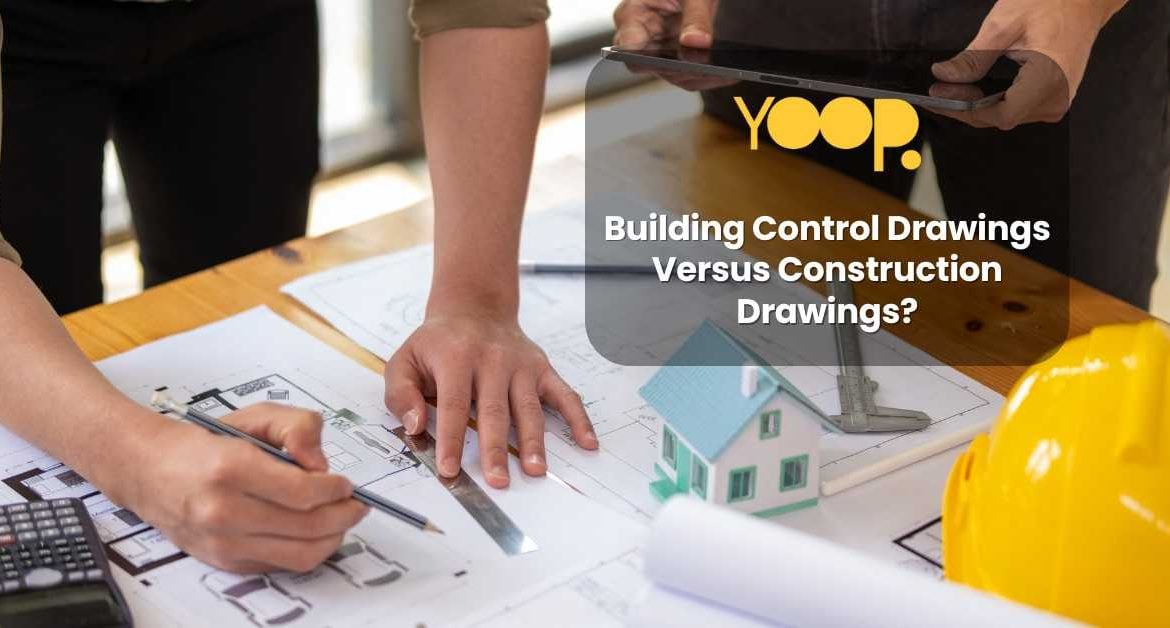
Building Control Drawings Versus Construction Drawings?
There are two very essential types of drawings that one finds while embarking on the home improvement journey: Building Control Drawings and Construction Drawings. These types tend to be generally misunderstood but they serve different purposes and are very important to a successful project. This knowledge could assist in a straightforward and compliant renovation, extension, or new build.
Embarking on a construction project can feel overwhelming. For homeowners, the terminology alone can be confusing, especially when it comes to Building Control Drawings versus Construction Drawings. Yet, both are equally vital, though for different reasons.
In the UK, like most countries, we must adhere to strict building regulations. These standards, often referred to as Building Codes elsewhere, are crucial. They exist to ensure the safety, security, and resilience of your property. This is where Building Control Drawings come into play. Their primary purpose? To demonstrate compliance with these regulations to the local Building Inspector.
Without these drawings, your project may hit frustrating roadblocks, delays, or worse—be deemed unsafe. It’s not just about avoiding penalties but about creating a secure, well-built space for you and your loved ones. These plans focus on aspects such as structural stability, fire safety, and energy efficiency.
On the other hand, Construction Drawings dive deeper into the actual building process. They guide your builder on how to bring your dream home to life, specifying details like material choices and finishes.
What Exactly are the Building Control Drawings?
Building Control Drawings are the technical plans picturing how your work project is in accordance with building regulations, which govern the final building to be safe, energy efficient, and accessible.
Primary Features of Building Control Drawings:
Compliance: It is all about structural integrity, fire safety, insulation, ventilation, drainage systems.
Approved: This would require submission to your local building control authority for approval from before any construction.
Simple Plane: They are less detailed compared with the construction drawings but focusing on statutory requirements.
- Examples of Building Control Elements:
- Wall thicknesses and insulation details.
- Window and their safety features.
- Foundation depth and type.
- Calculation for structural beams.
Key Differences Explained:
- Building Control Drawings:
- Purpose: To prove your build meets legal standards.
- Focus: Regulations and safety compliance.
- Audience: Primarily reviewed by Building Inspectors.
- Construction Drawings:
- Purpose: To provide a roadmap for builders during construction.
- Focus: Detailed construction methods and design elements.
- Audience: Used by architects, contractors, and builders.
Understanding both helps smooth the journey from idea to completion, ensuring you’re not caught off guard by unexpected challenges.
What Are Construction Drawings?
Construction Drawings, as many may know, are also called working drawings. Construction Drawings are very detailed, and they guide contractors while executing the project. Everything about construction is provided in these drawings to bring life to the design.
Key Features of Construction Drawings:
Execution-Oriented: These drawings tell how the project is really going to be built.
Resolution: and then through different such features, like dimensions, materials, finishes, and methods of installation.
Collaborative Use: The architect, engineer, contractor, and tradesperson on site will use them.
Examples of Construction Drawing Elements:
- Floor plans, elevations, and sections.
- Joinery details, fixtures, and fittings.
- Electrical and plumbing layouts.
- Specifications and quantities of materials.
Building Control Drawings and Construction Drawings: What’s a Building Inspector?
When navigating the world of Building Control Drawings and Construction Drawings, it’s essential to understand the role of a Building Inspector. These professionals are employed by local councils or approved private inspectors in the UK. Their job is to ensure that your project adheres to all relevant building regulations and standards.
Building Inspectors review Building Control Drawings to confirm that the proposed work meets the required legal standards. These include critical areas such as fire safety, energy efficiency, and structural integrity. Throughout the build, they also conduct site visits, checking that the construction matches the approved plans. If the project fails to comply, the inspector has the authority to halt work or even demand adjustments.
Having a strong grasp of what a Building Inspector does not only saves time and resources but also ensures that your project remains safe, legally sound, and completed on time.
They oversee a project and ensure compliance with the Building Regulations (Approved Documents). They do this in 2 stages. On plan and on site.
On Plan
This stage is where the Building Inspector receives the Building Control Set from the Architect and makes sure they are happy that it complies. Some times there are minor amendments at this stage as sometimes there are a number of different ways to do things and also the rules are moving more towards a risk based system rather than just straight rules. Once all is deemed compliant, the Building Inspector can issue Full Plans Approval. So if you build it as these standards it will comply.
On Site
So who is to say the Builder will built it as per the Building Control Drawings? For example all those insulations look the same but they are not! The Building Inspector not only doe the full plans approval but will oversee the on site construction. They attend site at key times. For example, before concrete can be poured for foundations the Building Inspector will view the depth to make sure that it is suitable for the ground conditions, tree in proximity etc. This is why a Home Owner should have contingency for the foundations, they can always go deeper due to unknown ground conditions. Make sure you have a rates for extra foundation in you Builders quote, so you know what the cost is before hand.
Building Control Drawings also show electrical switches and sockets. This is useful for the Home Owner to engage and make sure they have the sockets where they want them. The best way of Control Drawings Versus Construction Drawings is have your Architect update the furniture layout. The furniture position usually dictates where you want sockets for the TV, lamps, lighting etc.
The List of Approved Documents that Builders should be building to.
- A: Structure
- B: Fire safety
- C: Site preparation and resistance to contaminants and moisture
- D: Toxic substances
- E: Resistance to the passage of sound
- F: Ventilation
- G: Sanitation, hot water safety and water efficiency
- H: Drainage and waste disposal
- J: Heat producing appliances and Fuel storage system
- K: Protection from falling, collision and impact
- L: Conservation of fuel and power
- M: Access to and use of buildings
- N: Glazing – Safety in relation to impact, opening and cleaning
- P: Electrical safety
- Q: Security – Dwellings
- R: High speed electronic communications networks
- 7: Materials and workmanship
Construction Drawings
These drawings differ from Building Control Drawings as their main focus is showing the builder how it all goes together. Detailed sections show where the roof meets the wall and where the wall meets the foundation, the relationship to the ground etc.
These drawings should also show steel positions and how they are insulated or decorated, ie wrapped in plasterboard.
A lot of Architects will show all the information together. So it looks like one set of drawings. Hence the confusions.
So why would you split the sets of information?
For the same reason when cooking a roast dinner you put on the roast in the oven first? Why? Because it takes the longest. You now have time to do the vegetables and such.
So we produce the Building regulation Set, issue this to the Building Inspector, Home Owner, Engineer, Contractor if known. Its usually quite quick, This allows;
What is the Importance of Both Sets?
The two sets of drawings are critical for a project to be successful:
Building Control Drawings ensure your project meets the legal and safety requirements.
Construction Drawings provide the finer detail necessary to bring the design to life.
Building Control Drawings can lead to non-compliance with the regulations that can cause judicial delays or issues. Construction Drawings help builders to visualize the design and bring accurate dimensions that prevent costly mistakes and mismatched expectations in the end.
The Inspector to comment on it all is correct.
Allows the Home Owner to change things and still easy, update furniture layouts, look at lighting positions, utility tweaks, roof light tweaks etc.
Allows the Structural Engineer to design the structure and foundations including roof structures.
All the comments come back to the Architect. The changes can be incorporated and now the job can be completed by creating the Construction Drawings. This has more detailed information and will take the Architect more time to create. This also means it is a harder set of information to change. So it makes sense that everyone should comment prior to this set being produced. The Building Control Set is faster so allows everyone to receive information quickly and each progress what they have to do. This in contrast to the Architect producing all the Construction Drawings incorporating the Building Control Information. Everyone one would have to wait for this information. Once received, the Home Owner, Engineer, Building Inspector may want changes! So then the Architect is having to amend what was a finished set.
Did this make sense? Questions and comments in the comment section below. Please share with other that would benefit from this information.
The Approved Documents (Building regulations in Full)
Choosing Your Perfect Blueprint Partner
Now that you understand the distinct roles of these drawings, the question remains: which one do you need? The answer is simple – both! However, the order is crucial. Building control drawings come first, securing your project’s legitimacy. Once approved, construction drawings provide the intricate roadmap for bringing your vision to life.
Some architects offer combined drawing packages that encompass both aspects. Ultimately, discussing your specific needs with a qualified architect is the best course of action. They can guide you through the drawing process, ensuring you have the right tools to navigate your building project smoothly and successfully.
How Yoop Architects Can Help
We specialize in producing harmonious Building Control and Construction Drawings at Yoop Architects.
Our process includes the following:
Full Compliance – Undertaking that all required building regulations are complied with for your designs.
Detail Execution Drawing – Producing construction drawings which now detail all aspects of your build.
Expert Collaboration: Collaborating closely with all engineers, contractors, and local authorities for a more seamless process.
Tailored solutions: Customizing plans to meet your specific project needs and keeping compliance from the very beginning.
We made home improvement complications easy for you so you could get to your dream safe space.
Ready to Get Started?
Plan to renovate, extend or newly build? Let Yoop Architects guide you through every step. We’re with you every step of the way, from compliance to construction.
📞 Contact us today to discuss your project and see how we can bring your vision to life!

